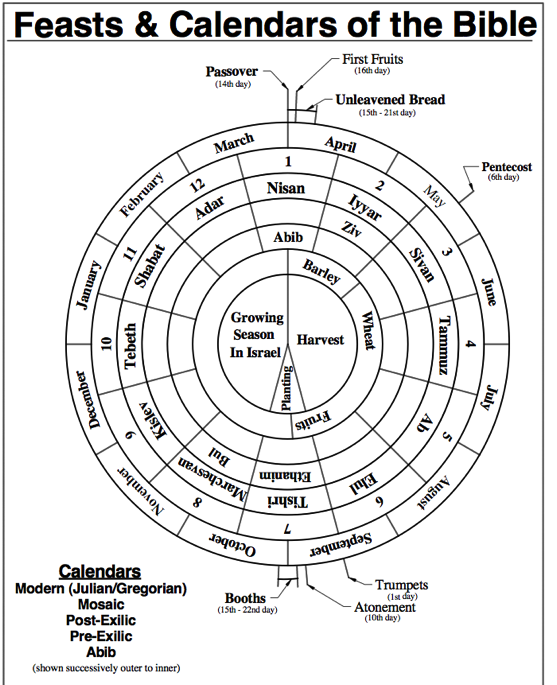Support for this Ministry depends upon viewers like you who enable us to produce biblically sound programs and materials. Please consider giving a tax deductable gift to meet our needs. Thank you!
All donations to CMI are tax deductible under IRS 501 (c) (3).
Calendars of the Bible
By Robert Congdon
Explanatory Notes
Understanding the chronology of events in the Bible is often critical in interpreting a Biblical passage. Knowing when some event occurred explains a person's actions. For example, in Nehemiah 2:1, Nehemiah reveals his sadness before the king for the first time. Because this was not done by cup bearers, he risked the king's displeasure and censure. The answer as to why he did this lies in noting the month-Nisan (Neh. 2:1). If one is unfamiliar with the calendar, this means little. But anyone who understands the importance of the month of Nisan understands what moved Nehemiah.
In Kislev (Neh. 1:1), Nehemiah learned of the dismal state of Jerusalem and became very upset (Neh. 1:4). Yet, Nehemiah remained silent for four months. Why during Nisan could he no longer control his emotions? By looking at the events of Nisan and seeing that this was the first month of the Mosaic/Biblical calendar, one sees that it was Passover. The Jewish Passover sacrifice can only be performed at the Temple in Jerusalem. Each year at Passover, a Godly Jewish person in exile, such as Nehemiah, felt a deep sadness and longed to see Jerusalem with the Temple restored, so that the Passover could once more be observed at the Temple site.
This chart enables one to compare specific Biblical dates, even when the events are recorded using different calendar systems. Four calendars are used in the Bible. Relating them to the modern calendar results in five calendar systems.
In order to coordinate the five calendars, one must first understand the concept of the circular calendar key (see Figure 1). Each concentric circle represents a calendar used by the Biblical writers (the modern calendar excepted). ®
Figure 1
Abib Calendar
The origins of this ancient calendar are unknown. It is not Phoenician nor Canaanite. It is a lunar calendar which begins in the spring. It is referenced only four time in the Bible. All references are to the month of abib and to when Israel ìcame out of Egyptî during the Passover.
It is an agricultural calendar based upon the meaning of abib (ripened). Abib is always associated with the barley crop. This is the only known month name for this calendar. ®
Pre-Exilic Phoenician Calendar
This calendar is believed to be a lunar Phoenician calendar because the names of the months are of Phoenician origin. The Bible records only three of the months on this calendar in 1 Kings 6 and 8. It should be remembered that Solomon had Phoenicians as the skilled craftsmen and recorders of the work of the Temple.
Ziv means month of flowers, Ethanim - month of perennial streams, and Bul - rain or showers. The remaining names can be found in extra-Biblical Phoenician materials. ®
Post-Exilic Babylonian Calendar
Upon the return to Israel, the Hebrews brought back many aspects of the Babylonian culture, including this calendar. The fact that it was a lunar calendar and began in the spring, made assimilation easier. Ezra, Nehemiah, Esther, and Zechariah use this calendar. Certain references facilitate cross-referencing with the Mosaic or Biblical Calendar (i.e., Esther 8:9).
It is important to note that during this period in Israelís history, both calendars were in use. Nehemiah, being the kingís cup bearer preferred to use the Babylonian Calendar, while Ezra used the Mosaic in all references but one. ®
Mosaic or Biblical Calendar
This calendar is the true Hebrew calendar of God. It was God who instructed Moses to name the months and start the year in the spring (Exodus 12:2). God simply named the months numerically, i.e. first month, second month, etc. At that time, the peoples of Palestine, being agricultural, started their calendar systems in the early autumn, with the olive harvest. Likewise, the Gezer/Egyptian calendar was another agricultural calendar of the day. However, the Hebrew calendar was to be a unique memorial commemorating the birth of the nation of Israel. Further, Israel and the things of Israel were not to reflect the pagan world. ®
© 1997 Robert Congdon



